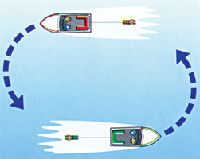Water skiing
Water skiing involves towing people behind a boat on skis, bare feet, inflatable toys, boards and parasailing. Whether you own or just borrow the boat or personal watercraft (PWC) for water skiing, you must know your responsibilities.
General safety obligation
Owners and operators have a general safety obligation to make sure their boat or PWC used for water skiing:
- is in good condition
- is used safely
- has the correct safety equipment.
The driver of the boat or PWC used for water skiing or towing someone else must be appropriately licensed with a recreational marine driver licence or personal watercraft licence.
All boats and PWCs used for water skiing or towing someone else must be registered.
Safety equipment that must be carried on board depends on the type of boat or PWC and where you are operating.
Find out more information about safety equipment.
All skiers must wear an appropriate lifejacket that fits them and is suitable for their activity and where they operate.
 Water skiing rules on the water
Water skiing rules on the water
Water skiing should always be done in an anticlockwise pattern, unless local signs or site management says otherwise. Always check before skiing.
You must carry an observer (who is 13 years or more) on board the boat or PWC that is towing someone else. The observer should be competent to promptly, clearly and consistently communicate to the operator if there is a danger, or potential for danger, to the skier; or the skier signals the observer; or the skier has a mishap.
The following factors should be considered in assessing competence:
The observer must:
- possess sufficient maturity, concentration and boating safety awareness to perform the tasks, having regard to the prevailing conditions. Prevailing conditions may include but are not limited to:
- the speed, acceleration and handling characteristic of the boat on which the person is an observer
- the layout of the waterway including the navigable width of the waters and locations of aids to navigation and hazards
- the nature and number of other boats and skiers operating in the vicinity
- weather and sea conditions such as tide/current flow, wind speed and direction, and wave or chop height.
The observer must not:
- suffer a hearing, sight or other disability or impairment to an extent which would affect the observer’s ability to perform the required tasks
- be under the influence of drugs or alcohol.
Water skiing speed and restricted areas in Queensland
Water skiing is prohibited in:
- certain restricted areas usually designated by signs
- designated Gold Coast areas outlined in the Transport Infrastructure (Waterways Management) Regulation 2012. Schedule 1, part 2, division 4 Transport Infrastructure (Waterways Management) Regulation 2012.
When water skiing, it is also important to remember that:
- all boats (including personal watercraft) must not exceed the speed limit.
-
Personal watercraft must not operate at a speed of more than 6 knots within 60m of:
- a person in the water
- a ship at anchor, moored, made fast to the shore of aground
- a jetty, wharf, boat ramp or pontoon in or on waters
- the boundary of a bathing reserve.
-
Ships must not operate at a speed of more than 6 knots within 30m of:
- a person in the water
- ship at anchor, moored, made fast to the shore of aground
- a jetty, wharf, boat ramp or pontoon in or on waters
- a diver's flag.

